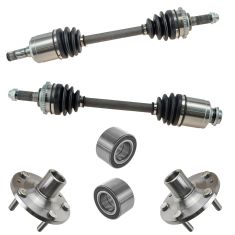1AACS00150-Ford Fusion Mazda 6 Mercury Milan Front Driver & Passenger Side 2 Piece CV Axle Assembly Set TRQ CSA82531

Replaces
2008 Mazda 6 i Front Driver & Passenger Side 2 Piece CV Axle Assembly Set TRQ CSA82531

Product Reviews
Loading reviews
4.43/ 5.0
7
7 reviews
Love this site!
July 21, 2018
I have yet to get my axles replaced due to mechanics scheduling but whenever I need anything for my car 1a never fails me with their prices. So glad I found them! Best prices around!
December 25, 2018
Fit well and my car runs smoothly definitely continuing buying products from 1a auto
Not balanced
February 4, 2019
I bought a pair of these to replace the worn out factory cv shafts. Fitment was fine, no more clicking noises either. Just one big problem with them, they are not balanced properly. My car now has a very noticeable shake between 55 and 70 mph. Not such a great deal after all. I guess you get what you pay for.
Front axle
July 8, 2019
The cv axles i have bought from 1 aauto worked perfect havent had any problems with them i am more than likely to buy from this store again for future parts
Works Perfectly
August 18, 2019
These CV Axels were much needed on my Mazda 6. I though this was a great deal for both the driver and passenger side axels. My old CV axel boots were destroyed and spewing the green, cakey grease. I was happy with the price and quality of the product.
September 23, 2021
It's been amazing it was very much needed.
December 28, 2021
Great fit
Customer Q&A
Can these fit a 2006 mazda 6s ?
September 28, 2023
10
No, These parts are listed to fit the 2006 Mazda 6i.
September 28, 2023
Kemal S
Does it work for Mazda 6 2005 2.3L?
May 20, 2024
10
Yes, this part will fit your vehicle.
May 21, 2024
Emma F
Mazda is a registered trademark of Mazda Motor Corporation. 1A Auto is not affiliated with or sponsored by Mazda or Mazda Motor Corporation.
See all trademarks.














